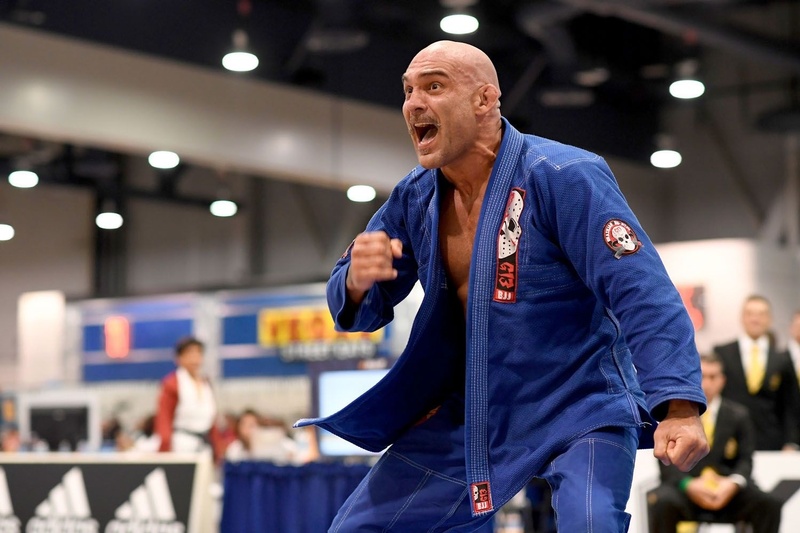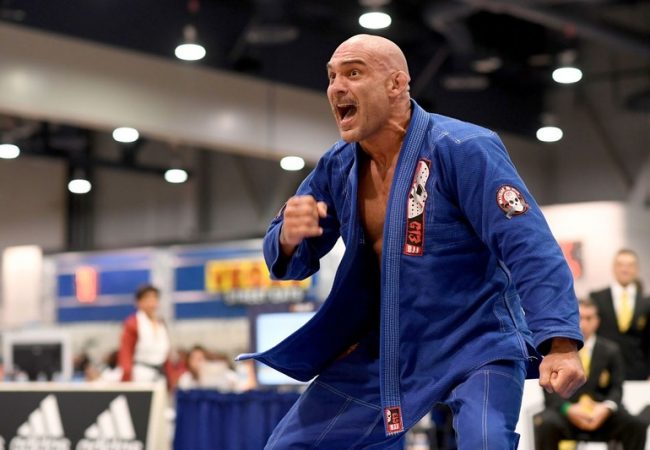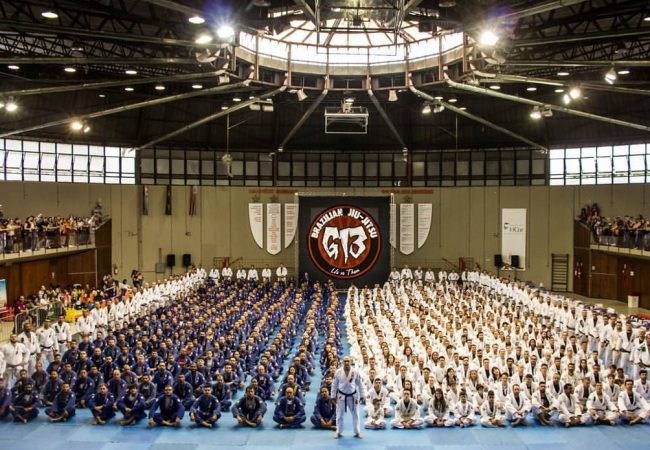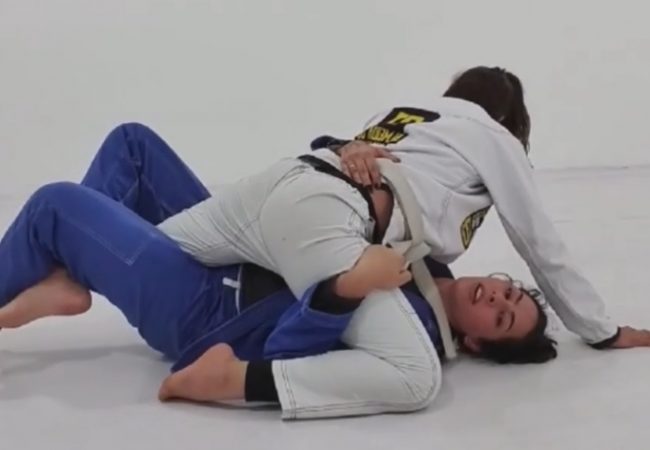A respected teacher and fierce competitor, with countless titles in Brazil and abroad, Roberto Godoi has already accumulated more than three decades of a firm commitment to Jiu-Jitsu. The road was long and full of challenges, but the professor, who always liked to test himself, has endured over the years and built his image in parallel with the G13BJJ, a team which he led in Brazil and now leads in american soil, furthering the reach of the gentle art in the US and spreading the benefits of Jiu-Jitsu among its people.
We’ve talked with Godoi and the chat revisited great moments in the teacher’s trajectory, from the first contact with the sport and his first academy to the analysis of his many years as a black belt, including valuable tips for you to successfully walk the path of constant learning in the gentle art.
Check the interview below and learn with Roberto Godoi!
GRACIEMAG: First and foremost: how did your classic nickname, “Jason” come about?
ROBERTO GODOI: (Laughter). That’s a good one. The nickname was born at Waldomiro “Junior” Perez’s academy. I was one of the toughest workouts in the gym and almost always wore a dirty gi that had a rip or two. Despite being young at the time, I also never had much hair, and this all coincided with the success of the films in the series “Friday The 13th”. When Junior was going to separate the training duos, he would say: “Go, you’ll train with Jason!”. But the one who made the nickname stick and led me to embrace it was a good friend of ours, who developed my first patch for the gi; when I saw it, it was a Jason doll in a mask and gi! The younger kids always thought it was awesome, but I never really cared.
You have more than three decades in Jiu-Jitsu, with more than twenty of those years as a black belt. What has been the most memorable experience in all these years?
That’s right, I was promoted to black belt at the end of 1996, and for many years I’ve proudly carried it around my waist. I fondly remember my first fights as a black belt, at the 1997 IBJJF Hawaii Pan. At the Jiu-Jitsu World Championship, I got third place at Tijuca Tênis Clube and it was a unique moment. We used to live real adventures, with car caravans leaving São Paulo, crashes in the Serra das Araras, the suffering of weigh-ins the day before… I remember this one time i ran around the gym for three hours and still had to weigh naked to beat the limit and be allowed to fight. We stayed in small fifth-rate hotels, huddled together, sneaking in the middle of the night so the managers wouldn’t notice. These are stories that people hardly believe nowadays.
It’s been more than thirty years competing nonstop. How do you think this constancy in the championships helps you, as a teacher and as a citizen?
Nowadays, as a 47-year-old athlete, my body now recovers from the various injuries I’ve had during that time, and with that comes some limitations, but that’s not going to stop me, at least not now! I’m passionate about that feeling of stepping on the mat, testing myself, listening to the guys saying that so-and-so is in my division and that he’s trained hard to win. It’s these feelings that keep that child’s flame burning inside me, the desire to train similar to when I started in the sport. Competing also makes me a better professional every day – the objective is not to prove anything to anyone but to pursue the continuous evolution and balance of my Jiu-Jitsu, not to mention the improvement of our group as a whole.
It’s that Rickson Gracie quote, studying and learning never end…
Yes, because Jiu-Jitsu evolves and modernizes every year. I know I have a lot to learn and improve; with that, competing and training with my students daily forces me to keep up to date with the latest in our art. Furthermore, championships are great for seeing friends, sharing laughs, expanding our network of contacts, among many other benefits for a teacher.
How did you start training Jiu-Jitsu?
Jiu-Jitsu came into my life by chance. When I was a kid, the school I went to sometimes had fights, and in my class, there was a kid from Argentina who could hold his own in a brawl. One day, this guy went to Rio de Janeiro for the year’s end and came back shocked. He called me and said: “If you don’t want to be beaten by anyone else in your life, you have to learn what I saw in Rio!”. He had visited a Gracie academy and said that he had been twisted in every way: “Dino (that was my nickname), this is what you need to practice, it’s called Jiu-Jitsu!”.
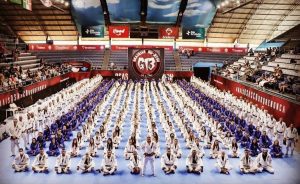
And was it easy to find a gym in São Paulo?
I learned that Marcelo Behring, who was already a famous champion trained by Rickson, had just arrived in São Paulo in 1988. I went there but the gym was too sought after and the training was expensive, so I couldn’t afford it. I got lucky that my brother came back from the US and gave me a brand new jacket, which I sold for the price of three months of training and got started. It was there that I met Waldomiro, who was Marcelo’s right-hand man and later would be my teacher and great friend.
What was the most memorable fight of your career?
All of them had their valor and brought great learning. But I don’t feel able to summarize in a moment, or personal achievement, my entire trajectory in Jiu-Jitsu. My greatest achievement in the sport was, without a doubt, the number of people and lives I could help improve, not only those who trained with me but their families and friends as well.
Do you still remember your first gym?
I was still a purple belt, in 1992, when, alongside a friend, I decided to set up the first gym I had, in the back of my house. It was small there, with enough room for about 15 students per class, and in the first month we already had 30 students training – and about ten waiting for a vacancy. Today, our G13BJJ school has been structuring itself more and more at the company level and seeking to give full support and feedback to its franchised students and teachers. The structure is unimaginable, comparing it to that gym in the back of the house. Our concern today is to ensure that G13BJJ is seen and recognized as a “martial arts school”, with us fulfiling our role as good educators.
We teach both students who think about competing and those who dream of being an entrepreneur and knowing how to teach and manage their own business one day. Today we have more than 7,000 students in 71 units, 55 of those in Brazil, between São Paulo, Minas Gerais, Tocantins, Bahia, and Santa Catarina. Outside Brazil, there are five in the US and one in Australia.
What tips would you give to succeed in Jiu-Jitsu and reach a black belt?
It is difficult to summarize in a few tips, because there are many variables involved. But I would say number one is discipline, to train constantly and not give up; the second is health – for your machine to work well, take care of it; the third is self-confidence: believe in yourself, and don’t let anyone or anything tell you that you can’t or aren’t capable!
Will effort always beat talent in Jiu-Jitsu?
I’m sure talent without discipline and a lot of effort gets us nowhere. Since I was a kid, I liked to fight, but I’ve always been tougher and more persevering than a talented guy himself. In several of the fights and championships I’ve won, I’ve been successful knowing that to be victorious I would first have to overcome my lack of talent. I’m certainly a tougher guy today because I have that focus and because I know what I’m made of. I always strive to be a better Godoi today than I was yesterday.
One of your strengths is sticking your hand in the collar, standing or on the ground, always triggering a blow… How does this tactic of yours work?
We must first remember that our fight starts standing up before going to the ground, so it is evident that, whether for takedowns, sweeps, or pulling to guard, all positions have their preparations and nuances, especially these details of grips on collars and sleeves to make it happen successfully. Standing, I try to exert my dominant left-hand grip on the opponent’s collar, and when I get it, it opens up a good range of attacks and positions for me, details that I pass on to everyone on our team. But Jiu-Jitsu isn’t always what we want, it’s the opportunities that arise at the time of the fight, so in our routine training at G13, we focus on both our strong game and our weak side, to try to increase the balance and elevate our game.
You’ve done seven MMA fights and started back in 1995. What did you learn about Jiu-Jitsu and about yourself stepping into these rings?
Those were different times, in which it was a natural way to migrate and fall into MMA at some point in their trajectory, even to seek this “validation” of their degree. And with me, it was no different. I learned several lessons in MMA and I am grateful for each experience that today adds to the baggage I have, and so I can contribute to achieving the goals of my athletes, be those professional or not. My dream is to serve as a ramp for all my students to reach much further than me.
You, like many teachers, went through a change of image that is similar to the evolution that took place with Jiu-Jitsu: in the past, it gave a strong image; today, you resemble a father of the students, respectful, cordial to opponents… Is the current Jason a peaceful one?
Yes, it’s a natural maturation of mine as a person, which happened in parallel with the transformation of Jiu-Jitsu’s values as a sport and a lifestyle around the world. I was at the front of a group and was a “master” very early on, and with this immaturity, I had my mistakes, but also my successes. Back then, that was a stereotype stuck in most Jiu-Jitsu fighters, but nowadays I’m better prepared as a person, in every way, to fill my position. I owe much of this to my parents and to what I learned in Jiu-Jitsu, for being this unique tool for emotional balance and rescue of moral values that, practiced daily, shapes us and those around us so that we can have a more harmonious and all-around better society.
In 2001, Godói-Macaco, which had been projected on the São Paulo sports circuit, broke up. What lessons did you learn from the breakup?
Godoi-Macaco in its heyday was unique, and whoever lived that, lived! I won’t take it for granted and am proud of everyone who went there. I don’t mean to besmirch so many others who fought hard for it in SP, but we were one of the main reasons for the rise of Jiu-Jitsu in São Paulo and Brazil at the time. We helped build it in São Paulo and I always believed in myself, I knew my role and value within the team. This was reflected in my self-confidence and total security, which didn’t make me fear the separation or starting from scratch. But that’s the summary of Jiu-Jitsu, the art prepares us to be champions in life. I just focused on work, not listening to the naysayers, because “the dogs bark and the caravan passes by”.
In December, it was ten years since Ryan’s death. What do you think was his importance for Jiu-Jitsu?
Ryan’s loss represented the loss of a great fighter, it was great human material. But Ryan lost to himself. Often the biggest battles we face in our lives are not against face-to-face or physical body opponents that we can physically hit. That’s why the fight is often unequal and why we shouldn’t judge anyone. Controversial or not, he was always an aggregator and was regarded by his students as a natural leader. His coming to SP, regardless of all the “causes”, did contribute to the promotion of Jiu-Jitsu in our state and revealed many athletes and friends which I’ll carry for the rest of my life. Nowadays, they carry his legacy and name around the world.


